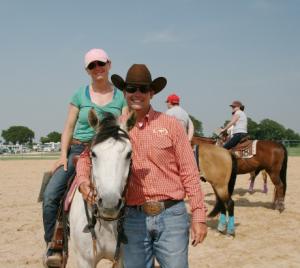by Leigh Ballard
Rossville, TN resident Elizabeth Wilson attended a Downunder Horsemanship Clinic April 25 – May 5 at Clinton Anderson’s ranch in Stephenville, Texas. The clinic was an intensive ten-day learning experience, taught by the natural horsemanship clinician. Four of Anderson’s DownUnder Horsemanship Academy students, who are clinicians-in-training, and two of his certified clinicians were on hand, supplementing instruction for the 30 participants.
Elizabeth attended with her small pony hunter, Rollingwoods Up In Smoke, aka “Little Miss Muffett.” Muffett is a 5-year-old ,13 hand Welsh pony mare by Rollingwoods Easy As L, aka “Elliott,” out of Rollingwoods Stick Em Up, aka “Emmie,” from Rollingwoods Farm in Olive Branch, MS. Rollingwoods’ ponies are bred to be all-around versatile hunter and carriage driving ponies, and Muffett is a good example of their versatility. Muffett was trained from the beginning by Elizabeth with a combination of natural horsemanship methods. The pretty grey pony has just started her introductory show career this spring at the MegFord schooling shows, placing in a low hunter class on her first show outing.
Participants were allowed to bring only one horse. Elizabeth chose the pony because she wants Muffett to develop into a safe and useful go-to, all-around pony for her children. She was confident her experience at Clinton Anderson’s would help achieve that goal. The riders were from various disciplines, and horses at the clinic included a Tennessee Walking horse, an Arab, but most of the horses were American Quarter Horses, ridden western style. The Tennessee Walking Horse had a rude awakening when he was required to canter or gallop for much of his work! Elizabeth rode Muffet in a Western saddle, even though her usual focus is English.
Participants travelled from as far away as Oregon, Maine, and Canada. Elizabeth’s eleven hour trip of was one of the shortest. Clinic attendees ranged in experience levels: from one who had bought her first horse and just started riding last fall, to those with extensive experience who want to make horse training their life’s career. There were 18- to 71-year-olds. The oldest participants were a retired couple who had each bought a Clinton Anderson Signature Horse, already trained extensively in Clinton’s method.
The typical clinic day started with classroom instruction. Then the students and their horses were put to work in the arena doing groundwork exercises. After a mid-day break, the afternoon work was riding exercises. Each day’s focus followed a progression through Clinton’s established methods in his Fundamentals Course. Over ten days the horse/rider pairs first established control with groundwork in the round pen, then moved to the arena, then moved outdoors to “the trees,” where they galloped and cantered circles and learned to conserve energy. Then they moved to ditches, learning to take their time and be careful going in and out, up and down. All exercises built on the previous exercises, so by the time the horse came to the daunting obstacle course, they were well prepaired. The obstacles gave the horses a reason to use the maneuvers and techniques they had been practicing.
The horses were ridden every day, with the riders given one day off from instruction; most used the time to practice what they had learned. Elizabeth was impressed by the change in fitness that was evident daily when the horses were bathed. The intense work level required that the horses be fed “high octane” rations. Elizabeth said, “Muffett usually eats about five pellets, but she was eating alfalfa hay and 4 pounds of feed twice a day!”
Muffett’s small size may have seemed like a deterrent to completing some of the tasks, but she did everything the big horses did. She scaled steep banks, jumped in and out of telephone pole obstacles that were as high as her chest, and never batted an eye. She was game for any challenge!
Muffett was especially challenged on the “cow chase” day. The exercise was to follow a cow, aiming for the cow’s ear, staying with it, and trying to control its direction. When the first horse and cow pair started, Muffett was immediately frightened by the strange creature, since had never seen a cow before. She backed and spun around, trying to get away. Clinton noticed and laughingly asked Elizabeth to be the second one out to work the cow. The cow was as big as Muffett! After a minute or two, Muffett settled in, locked eyes on the cow, and gave chase – hard! Then the cow was terrified and ran crazily into the fence. Muffet won!
Elizabeth said the clinic gave her a new impetus for expanding her horsemanship skills. The training and relationship-building with her pony were invaluable to both. What she learned she could ask of her pony, and finding what her pony was willing to do was special and inspiring.
Clinton Anderson trains several clinicians per year, who travel regularly giving clinics using his methods. After a rigorous year-long training academy, these clinicians are certified and launched into their own business, with support and promotion from Clinton Anderson. Elizabeth is tentatively planning a 3-day clinic at her barn in Rossville with one of his clinicians in September. Contact Elizabeth Burr Wilson on Facebook for more information.











